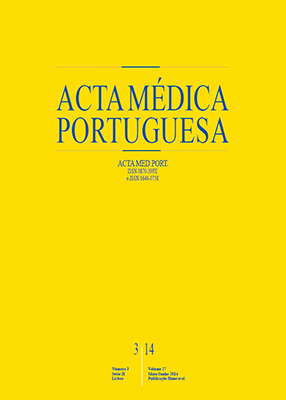Successful Pregnancies Outcomes with the Use of In Vitro Fertilization after Essure® Unilateral Hydrossalpinx Occlusion
DOI:
https://doi.org/10.20344/amp.4840Abstract
Introduction: Since two decades we witnessed the publication of several studies devoted to the study of the influence of the presence of hydrosalpinx on the results of embryo transfer techniques. The aim of this study is to present the results of treatment and pregnancy outcomes in women with a history of infertility associated with unilateral hydrosalpinx, visible on vaginal ultrasound, which were subjected to unilateral occlusion with Essure® and subsequent treatment with in vitro fertilization.Material and Methods: We performed a prospective analysis of a sample of 6 women, with a history of infertility and unilateral
hydrosalpinx, between April 2010 to May 2013. In all cases we proceeded to unilateral hysteroscopic placement of the Essure®
microinsert, prior to performing a cycle for in vitro fertilization.
Results: Of the 6 patients undergoing in vitro fertilization, 4 became pregnant (66.7%). Of these, two were uneventful pregnancies until delivery and 2 are still under surveillance, without complications. Of the patients who did not become pregnant after in vitro fertilization (n = 2, 33.3%), 1 conceived spontaneously during the subsequent monitoring.
Discussion: The advancement of hysteroscopy in the treatment of hydrosalpinx using the Essure® microinsert placement is a valid alternative to the laparoscopic approach.
Conclusion: This study suggests the effectiveness of unilateral tubal occlusion caused by Essure® microinsert in improving outcomes of in vitro fertilization treatment in cases of infertility associated with unilateral hydrosalpinx, visible in the vaginal ultrasound.
Keywords: Fertilization in Vitro; Hysteroscopy; Infertility, Female; Pregnancy; Live Birth; Sterilization, Tubal; Portugal.
Downloads
Downloads
Published
How to Cite
Issue
Section
License
All the articles published in the AMP are open access and comply with the requirements of funding agencies or academic institutions. The AMP is governed by the terms of the Creative Commons ‘Attribution – Non-Commercial Use - (CC-BY-NC)’ license, regarding the use by third parties.
It is the author’s responsibility to obtain approval for the reproduction of figures, tables, etc. from other publications.
Upon acceptance of an article for publication, the authors will be asked to complete the ICMJE “Copyright Liability and Copyright Sharing Statement “(http://www.actamedicaportuguesa.com/info/AMP-NormasPublicacao.pdf) and the “Declaration of Potential Conflicts of Interest” (http:// www.icmje.org/conflicts-of-interest). An e-mail will be sent to the corresponding author to acknowledge receipt of the manuscript.
After publication, the authors are authorised to make their articles available in repositories of their institutions of origin, as long as they always mention where they were published and according to the Creative Commons license.









